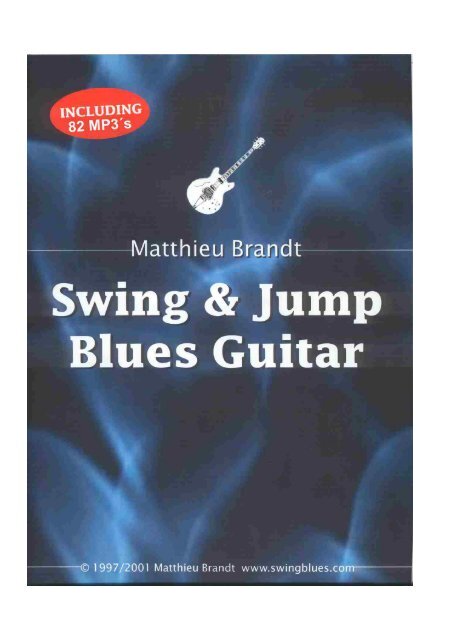a sample of the PDF file. - Swing Blues and Jump Blues Guitar
a sample of the PDF file. - Swing Blues and Jump Blues Guitar
a sample of the PDF file. - Swing Blues and Jump Blues Guitar
You also want an ePaper? Increase the reach of your titles
YUMPU automatically turns print PDFs into web optimized ePapers that Google loves.
Sample from <strong>the</strong> book '<strong>Swing</strong> & <strong>Jump</strong> <strong>Blues</strong> <strong>Guitar</strong>' by Matthieu Br<strong>and</strong>t<br />
67 pages / 100 tabs / 82 mp3's<br />
Note: Inner Logic<br />
The 7th <strong>of</strong> <strong>the</strong> I chord (in this case <strong>the</strong> G in an A7 chord) leads to <strong>the</strong> 3rd <strong>of</strong> <strong>the</strong> IV chord (<strong>the</strong> F# in D7). The<br />
3rd <strong>of</strong> <strong>the</strong> I chord (a C# in A7) leads into <strong>the</strong> 7th <strong>of</strong> <strong>the</strong> IV chord (a C in D7).<br />
This inner logic <strong>of</strong> a blues chord progression can also be used in your solos. The same logic can be applied to<br />
<strong>the</strong> V-I chord progression.<br />
Thirds<br />
Intervals Thirds Ex 1 – CD 7<br />
This example uses sets <strong>of</strong> third<br />
intervals, both major <strong>and</strong> minor.<br />
They are derived from <strong>the</strong><br />
mixolydian scale. Move <strong>the</strong>m up<br />
to <strong>the</strong> IV <strong>and</strong> V position to get <strong>the</strong><br />
riff for <strong>the</strong> C7 <strong>and</strong> D7 groove.<br />
All <strong>the</strong>se riffs are played relative<br />
to <strong>the</strong> tonic. Find <strong>the</strong> tonic first<br />
<strong>and</strong> <strong>the</strong>n play <strong>the</strong> riff. The tonic<br />
for this riff (a G) is <strong>the</strong> last note<br />
you play.<br />
Intervals Thirds Ex 2 – CD 8<br />
Again: <strong>the</strong> tonic <strong>of</strong> this riff is <strong>the</strong><br />
last note you play.<br />
Move this pattern two frets up to<br />
get <strong>the</strong> D7 chord variation.<br />
Intervals Thirds Ex 3 – CD 9<br />
Thirds are all over <strong>the</strong> neck.<br />
You can form a third interval<br />
on any two adjacent strings, like<br />
in example 3. Move this riff up 5<br />
frets to get <strong>the</strong> C7 variation <strong>and</strong><br />
ano<strong>the</strong>r 2 frets to get <strong>the</strong> D7<br />
pattern.<br />
Intervals Thirds Ex 4 – CD 10<br />
Ano<strong>the</strong>r groovy one that is<br />
similar to Hollywood Fats'<br />
riff in "She's Dynamite"<br />
Sample from <strong>the</strong> book '<strong>Swing</strong> & <strong>Jump</strong> <strong>Blues</strong> <strong>Guitar</strong>' by Matthieu Br<strong>and</strong>t<br />
67 pages / 100 tabs / 82 mp3's
Sample from <strong>the</strong> book '<strong>Swing</strong> & <strong>Jump</strong> <strong>Blues</strong> <strong>Guitar</strong>' by Matthieu Br<strong>and</strong>t<br />
67 pages / 100 tabs / 82 mp3's<br />
Note: Inner Logic<br />
As with tritone intervals, <strong>the</strong>re is an inner logic to playing third intervals over <strong>the</strong>se chords.<br />
Intervals Thirds Ex 5 – CD 11<br />
Whenever you use a riff with notes from <strong>the</strong> mixolydian scale <strong>and</strong> you change chords (for instance from G7 to<br />
C7), you've got to change scales.<br />
The first pattern on G7 uses notes from G mixolydian. On C7 you use notes from C mixolydian.<br />
These scales look a lot alike (see Scales / Chords). By changing only one note <strong>of</strong> <strong>the</strong> first G7 riff, you can use it<br />
on a C7 chord. Move this one up two frets <strong>and</strong> you're set for D7.<br />
Sample from <strong>the</strong> book '<strong>Swing</strong> & <strong>Jump</strong> <strong>Blues</strong> <strong>Guitar</strong>' by Matthieu Br<strong>and</strong>t<br />
67 pages / 100 tabs / 82 mp3's
Sample from <strong>the</strong> book '<strong>Swing</strong> & <strong>Jump</strong> <strong>Blues</strong> <strong>Guitar</strong>' by Matthieu Br<strong>and</strong>t<br />
67 pages / 100 tabs / 82 mp3's<br />
Whenever you play a riff with intervals or broken chords, <strong>the</strong>re is a good chance you can play <strong>the</strong> same riff on<br />
<strong>the</strong> IV <strong>and</strong> V chord.<br />
If it contains <strong>the</strong> third <strong>of</strong> <strong>the</strong> I chord (B in G7), move that note down one fret. Bingo!<br />
Move <strong>the</strong> riff up two frets from <strong>the</strong>re to get <strong>the</strong> V chord version.<br />
If <strong>the</strong> riff contains <strong>the</strong> seventh <strong>of</strong> <strong>the</strong> I chord (F in G7), you've also got to change <strong>the</strong> riff when you l<strong>and</strong> on <strong>the</strong><br />
V chord. Look at bar 9 <strong>of</strong> example 5. On beat two you're playing an F# on <strong>the</strong> B string, not an F!<br />
On <strong>the</strong> C7 <strong>the</strong> F sounds hunky dory because it's part <strong>of</strong> <strong>the</strong> C mixolydian scale.<br />
These kinds <strong>of</strong> riffs are used a lot by experienced players.<br />
Instead <strong>of</strong> moving all over <strong>the</strong> neck to play <strong>the</strong>se riffs, <strong>the</strong>y change one note <strong>and</strong> look way cool while giving <strong>the</strong><br />
girls (or boys ...) in <strong>the</strong> first row <strong>the</strong> eye.<br />
Sixths<br />
A more open way <strong>of</strong> playing intervals is by using sixths. The mixolydian scale is harmonised by adding a<br />
second note that is a sixth higher <strong>the</strong>n <strong>the</strong> original note.<br />
The Bb mixolydian scale has <strong>the</strong>se notes:<br />
Bb C D Eb F G Ab Bb<br />
1 2 3 4 5 6 7 8<br />
When you add a sixth, you get <strong>the</strong>se intervals:<br />
Bb-G, C-Ab, D-Bb, Eb-C, F-D, G-Eb & Ab-F.<br />
Hey, you'll never remember this if you're life depended on it. Look at <strong>the</strong>se examples to help you out. Focus<br />
your riffs on <strong>the</strong>se positions <strong>and</strong> vary <strong>the</strong>m to your liking.<br />
Intervals Sixths Ex 1 – CD 12<br />
The tonic <strong>of</strong> <strong>the</strong> chord is <strong>the</strong> first note you play.<br />
Move <strong>the</strong> riff up 5 frets to get <strong>the</strong> Eb riff (<strong>the</strong> IV<br />
chord) <strong>and</strong> ano<strong>the</strong>r 2 to get <strong>the</strong> F riff (V chord).<br />
Or play <strong>the</strong> IV chord riff like this:<br />
Intervals Sixths Ex 2 – CD 13<br />
Move <strong>the</strong> same riff up two frets for <strong>the</strong> V version.<br />
Sample from <strong>the</strong> book '<strong>Swing</strong> & <strong>Jump</strong> <strong>Blues</strong> <strong>Guitar</strong>' by Matthieu Br<strong>and</strong>t<br />
67 pages / 100 tabs / 82 mp3's



